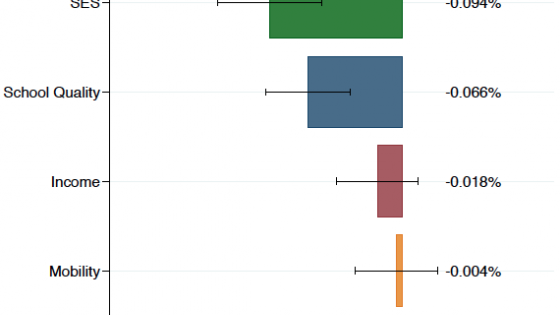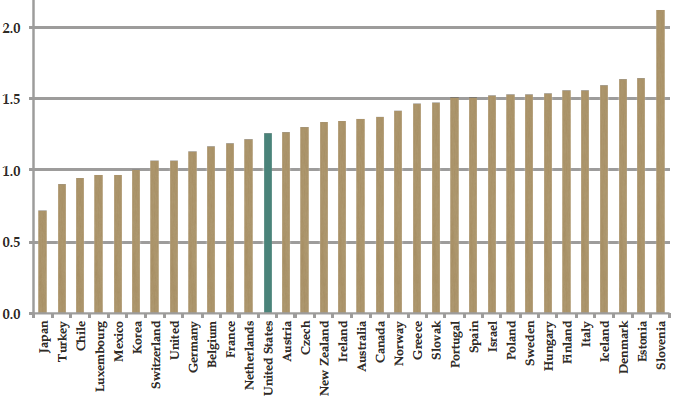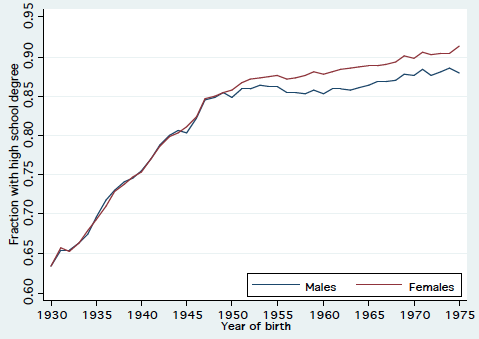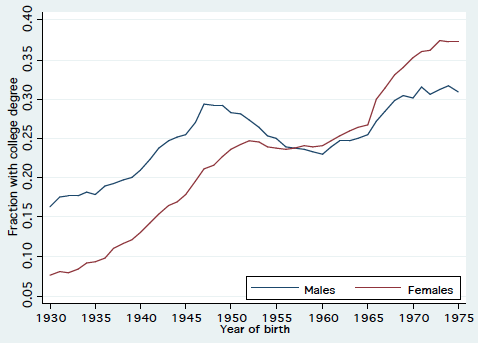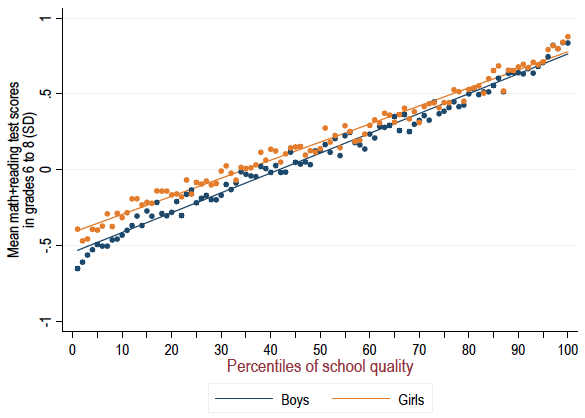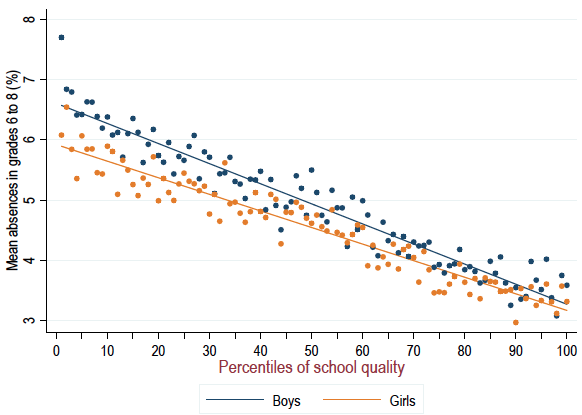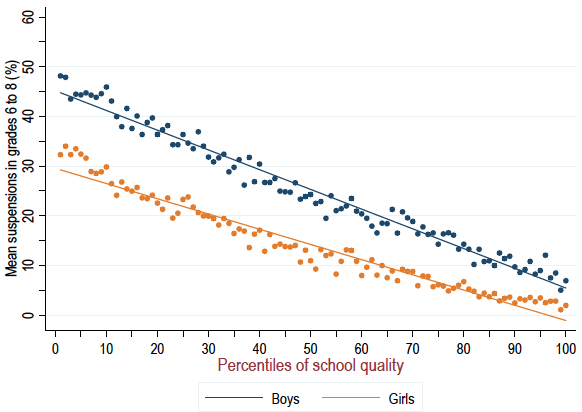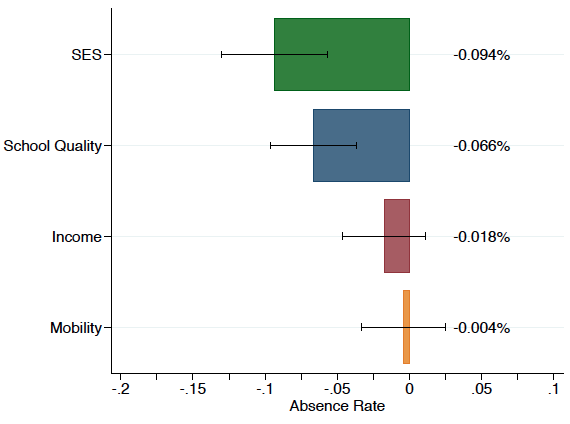Over the last three decades, women have surpassed men in educational attainment throughout the developed world. In 2011, more women than men completed college in 29 of the 34 OECD countries, with just five countries – Chile, Japan, Luxembourg, Mexico, and Turkey – having higher rates of male college completion. In the US, the current female high school graduation rate exceeds the male rate by five percentage points, and the female college graduation rate exceeds the male rate by seven percentage points.
Figure 1. Ratio of female-to-male college completion rates for OECD countries
Figure 2. The emergence of the gender gap in educational attainment, US 1930–1975 birth cohorts
a. High school degrees
b. College degrees
What explains the disparate progress of male and female educational achievement? Recent research shows that early childhood inputs are particularly important for the formation of boys’ cognitive skills and behavioural patterns. These childhood inputs range from family structure and living arrangements (Bertrand et al. 2013, Autor et al. 2016) to maternal employment (Fan et al. 2015) and poverty (Chetty et al. 2015).
There is also emerging evidence on the contribution of other environmental influences, such as schools, to the gender gap in children’s medium- and long-term outcomes. This research indicates that school inputs differentially affect boys’ and girls’ educational achievement, but little consensus exists over which sex is the main beneficiary. For example, studies of school vouchers document larger gains for girls if they are randomly assigned to their first-choice school (Hastings et al. 2006, Deming et al. 2014). On the other hand, teaching literacy or numeracy in primary school differentially benefits the sex with weaker average performance – literacy among boys and numeracy among girls (Machin et al. 2008).
Do schools amplify or mitigate the gender gap?
Using ‘big data’ from the US state of Florida, we study whether the quality of elementary and middle schools affects the educational achievement and behavioural gaps between boys and girls. By matching population-level birth and public school records, we can trace the academic trajectories of hundreds of thousands of children born in Florida between 1994 and 2002. We focus on three outcomes observed for each student in sixth through eighth grades: standardised test scores for maths and reading, rates of absenteeism, and the incidence of school suspensions.
To measure school quality, we compute the observed gains score – the fraction of students at the school who improve their maths and reading scores – for each elementary and middle school in Florida between the years 2002 and 2013, and rank these school-level, average gains into percentiles. We then assigned an average school rank quality to each student for the schools they attended from first grade onward.
The three figures below examine the relationship between school quality and academic and behavioural outcomes by plotting average scores in reading and maths, absence rates, and suspension rates of boys and girls as a function of the rank quality of the schools they attended. Consistent with prior evidence, children of both sexes achieve higher test scores and are less frequently absent or suspended at higher quality schools. But this positive relationship between school quality and students’ academic and behavioural outcomes is steeper for boys than girls. There is a sizable disparity between the sexes at the lowest quality schools, particularly for behavioural outcomes. For example, in the bottom 10% of schools, boys are one percentage point more likely to be absent and 14 percentage points more likely to be suspended than are girls. These behavioural disparities shrink as we move from left to right in the quality distribution. Indeed, there is essentially no boy-girl disparity in outcomes at the highest-quality schools.
Figure 3. Standardised maths and reading scores are higher, and the boy-girl test score gap smaller, at higher quality schools
Figure 4. Absence and suspension rates are lower, and the boy-girl outcome gap smaller, at higher quality schools
a. Absence rates
b. Suspension rates
Comparing brothers and sisters
These figures make a prima facie case that poor schools may be even more damaging to boys than girls. An alternative interpretation, however, is that the larger boy-girl disparity at lower-quality schools might be driven by non-school factors. In related work, we have shown that the gender gap in academic and behavioural outcomes is larger among children from more disadvantaged families (Autor et al. 2015). Since disadvantaged kids disproportionately attend poor quality schools, this relationship between school quality and the gender gap could be explained by sorting based on socioeconomic status alone. To address this concern, we contrast the outcomes of opposite-sex siblings who attend the same schools. We thus examine the effect of attending a high or low quality school on brothers’ relative to sisters’ outcomes, controlling for their family type.
Even after accounting for the differences in families across school types, the initial finding continues to hold – boys have substantially worse outcomes than girls in the lowest performing schools, but a sizable fraction of the gap is eliminated as measured school quality increases. For example, boys who attended the lowest quality schools perform on average one-eighth of a standard deviation below their female counterparts in reading and maths. Moving from the lowest middle school quality to the 50th percentile reduces the gender gap by 0.06 standard deviations, or by about one half.
As a final test, we contrast the outcomes of siblings exposed to schools of differing quality due to family moves across Florida school catchment areas. We find that both boys and girls benefit from attending a higher-quality school, and again brothers disproportionately benefit from a better school relative to their sisters.
When looking across outcomes, it is apparent that school quality affects the gender gaps in academic and behavioural outcomes differently – the initial gaps are smaller and generally decline less for academic outcomes in comparison to behavioural ones. This finding is consistent with our previous work on family environmental influences, in which gender differences in absence and suspension rates were the most responsive to family socioeconomic status (Autor et al. 2016).
Conclusions
How does the effect of schools on the gender gap in educational outcomes compare with the contribution of other early childhood inputs? Combining the results from our previous research on the effect of family disadvantage, neighbourhood income, and neighbourhood mobility on the gender gap in educational outcomes, the below figure summarises the contributions of each. Family socioeconomic status exerts the most influence on the gender gap in absences, with a one standard deviation change reducing the gap by 0.094 percentage points. School quality produces a smaller, but still sizable effect. The smallest effects stem from characteristics of the child’s neighbourhood.
Figure 5. The contribution of a standard deviation change in various environmental influences to the gender gap in absences
This leads us to conclude that overall, better schools are an effective policy lever in remediating gender disparities in elementary and middle school outcomes. Since these medium-term outcomes are highly predictive of high school completion, schools may have even longer-run implications for the gender gap in educational attainment.
References
Autor, D, D Figlio, K Karbownik, J Roth and M Wasserman (2016) “Family disadvantage and the gender gap in behavioral and educational outcomes”, NBER Working Paper No. 22267.
Bertrand, M and J Pan (2013) “The trouble with boys: Social influences and the gender gap in disruptive behavior”, American Economic Journal: Applied Economics, 5(1): 32–64.
Chetty, R and N Hendren (2015) “The impacts of neighborhoods on intergenerational mobility: Childhood exposure effects and county-level estimates”.
Deming, D, J Hastings, T Kane and D Staiger (2014) “School choice, school quality, and postsecondary attainment”, American Economic Review, 104(3): 991–1013.
Fan, X, H Fang and S Markussen (2015) “Mothers’ employment and children’s educational gender gap”, NBER Working Paper, No 21183.
Hastings, J S, T J Kane and D O Staiger (2006) “Gender and performance: Evidence from school assignment by randomized lottery”, American Economic Review, 96(2): 232–236.
Machin, S and S McNally (2008) “The literacy hour”, Journal of Public Economics, 92(5-6): 1441–1462.
